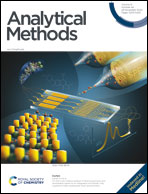Analytical validation of an ATR-FTIR based method for quantifying the amount of polysorbate 80 adsorbed on PLGA nanoparticles†
Abstract
Nanoparticle-based drug delivery systems for crossing the blood–brain barrier employ diverse strategies. Coating of nanoparticles with non-ionic surfactants is often employed for enhancing the delivery process. Polysorbate 80 is one of the non-ionic surfactants used as a coating agent for facilitating receptor-mediated endocytosis into the brain. However, very few studies have been done to quantitate the actual amount of the surfactant adsorbed onto nanoparticles. Earlier we had developed an extraction method of adsorbed polysorbate 80 from PLGA nanoparticles and used an attenuated total reflection Fourier transform infrared (ATR-FTIR) method for polysorbate 80 quantitation. Here we show the analytical validation of this method, for its suitability in various applications as per compliance set by regulatory bodies. The validation of the method was done by considering ICH and FDA guidelines for accuracy, precision, linearity, range, limit of detection, and limit of quantitation parameters. The method successfully complied with all the parameters and is therefore found to be suitable for successful use in industry and academia and by regulatory bodies.



 Please wait while we load your content...
Please wait while we load your content...